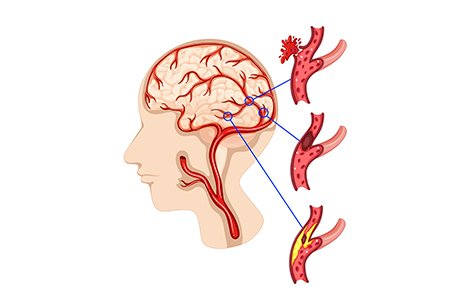
CVA Stroke
Acute stroke is also commonly called a cerebrovascular accident. . A stroke occurs when a blood vessel in the brain ruptures and bleeds or when there’s a blockage in the blood supply to the brain. The rupture or blockage prevents blood and oxygen from reaching the brain’s tissues. The better and more meaningful term is “brain attack”.
Without oxygen, brain cells and tissue become damaged and begin to die within minutes.
Classification :
There are two main types of strokes.
1) Ischaemic
Ischaemic strokes are the most common, accounting for up to 80% of strokes, and occur when there is an occlusion of a blood vessel impairing the flow of blood to the brain.
Ischaemic Strokes are divided into:
- Thrombotic – Where a blood clot forms in a main brain artery or within the small blood vessels deep inside the brain. The clot usually forms around atherosclerotic plaques.
- Embolic – A blood clot, air bubble, or fat globule forms within a blood vessel elsewhere in the body and is carried to the brain.
- Systemic Hypoperfusion – A general decrease in blood supply, e.g.,
- In shock
- Occurring in small vessels (lacunar infarcts) caused by chronic, uncontrolled hypertension resulting in the pathological entity of lipohyalinosis and arteriolosclerosis. These strokes occur in the basal ganglia, internal capsule, thalamus, and pons.
- Watershed strokes (see link).
- Venous Thrombosis
According to the TOAST classification, there are four main types of ischemic strokes.
- Large vessel atherosclerosis
- Small vessel diseases (lacunar infarcts)
- Cardioembolic strokes
- Cryptogenic strokes
2) Haemorrhagic :
- Intracerebral Haemorrhagic Stroke — There is bleeding from a blood vessel within the brain. High blood pressure is the main cause of intracerebral haemorrhagic stroke.
- Subarachnoid Haemorrhagic Stroke — There is bleeding from a blood vessel between the surface of the brain and the arachnoid tissues that cover the brain.
Transient Ischemic Attack (Tia Or “Mini-Stroke”):
TIAs are sometimes known as “warning strokes.” It’s important to know that:
- A TIA is a warning sign of a future stroke.
- A TIA is a medical emergency, just like a major stroke.
- There is no way to know in the beginning whether symptoms are from a TIA or from a major type of stroke.
- Like ischemic strokes, blood clots often cause TIAs.
- More than a third of people who have a TIA and don’t get treatment have a major stroke within 1 year.
- As many as 10% to 15% of people will have a major stroke within 3 months of a TIA.
Recognizing and treating TIAs can lower the risk of a major stroke.
Some experts do not classify Subarachnoid Haemorrhage as Stroke because subarachnoid haemorrhages present differently from Ischaemic Strokes and Intracerebral Haemorrhagic Strokes.
Regardless of the type of stroke, it is important to know that with each minute of large vessel ischemic stroke untreated, close to two million neurons die. This is the most important “time is brain” concept in understanding acute stroke and its treatment.
Causes :
- Hypertension, diabetes mellitus, hypercholesterolemia, physical inactivity, obesity, genetics, and smoking.
- Cerebral emboli commonly originate from the heart, especially in patients with preexisting heart arrhythmias (atrial fibrillation), valvular disease, structural defects (atrial and ventricular septal defects), and chronic rheumatic heart disease.
- Emboli may lodge in areas of preexisting stenosis.
- Alcohol intake has a J-shaped relationship with ischemic stroke. Mild to moderate drinking carries a slightly lower risk of ischemic stroke, yet heavier drinking increases the risk drastically.
- Alcohol intake increases the risk of hemorrhagic stroke in a near-linear relationship.
A stroke occurs when there is an interruption of the blood supply to a particular area of the brain,
Symptoms :
- Paralysis
- Sudden numbness or weakness in the arm, face, and leg, especially on one side of the body (hemiparesis)
- Sudden trouble speaking or understanding others
- Slurred speech
- Sudden confusion, disorientation, or lack of responsiveness
- Sudden behavioral changes, especially increased agitation
- Vision problems, such as trouble seeing in one or both eyes with vision blackened or blurred, or double vision
- Trouble walking
- Loss of balance or coordination
- Sudden dizziness
- Severe, sudden headache with an unknown cause
- Seizures
- Nausea or vomiting
Treatments :
- Sarvanga Abyanga for strengthening and nourishing the muscles. It is vata hara.
- Sashtika Shali Panda Sweda is a special type of sweda done using bolus of rice dipped in ksheera and balamoola kashaya. It is brihmana and has swedanakarma. Shashtika Shali has snigdha, guru, sheeta, sthiragunas and is tridoshaghna.
- Basti is considered as ardha chikitsa. It is useful in vitiation of all doshas.
- Matra Basti can be given in all seasons and is without complications.
- Pariseka with Dasamula Kwata is adopted to imbalances in Vata dosha. It targets bones, joints, muscles, and nerves, making it an invaluable remedy for various painful and inflammatory conditions.
- Nasya is indicated in urdhwajatrugatavikara. Patient had slurring of speech, Pradhamana Nasya with Brihatvatachintamani was administered, which is very useful in vakgraha, swarabheda, and indriyashuddhi.
- Kaya Seka / Pizhichil
- Nasya
- Shirodhara
- Kabalam
- Njavarakkizhi
- Sirovasti
- Elakizhi
- Mridu Sarvanga Bashpa Swedana
- Anuvasan Basti as Matra Basti
- Masha Pinda Sweda
- Mustadi Yapana Vasti
- Mridu Virechana
- Medhya Rasayanas

